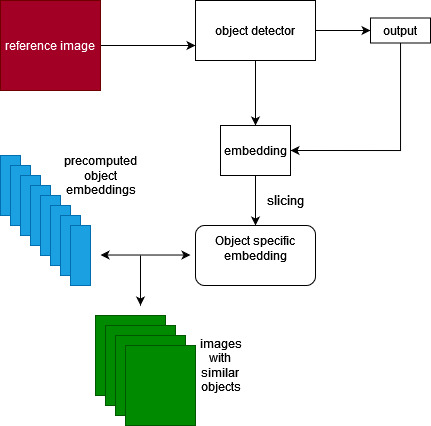Single-Shot Localized Retrieval using YOLOv3
A retrieval system that takes object selections as bounding box prompts from the user, given an image and retrievs similar objects from an image database.
What is this project about?
This project explores how neural networks can be used for content-based image retrieval (CBIR) — finding visually similar objects based on features learned by an object detection network. Instead of classifying images into rigid categories (dog vs. cat), this system extracts object-specific embeddings and uses them for similarity search and recommendations.
- Goal: Enable search, grouping, and recommendation of objects by visual features such as size, texture, color, and style — especially in product cataloguing contexts where users look for items that “look like this one.”
Problem Approach
- Traditional retrieval methods often rely on multi-step processes: first isolating an object manually, then extracting features in a separate step, and finally performing similarity search.
-
This project makes retrieval more efficient and scalable by using a single forward pass of the detection network to:
- Detect objects,
- Extract embeddings,
- And slice features for the chosen object.
This means location-specific retrieval happens in one step, avoiding the inefficiency of multi-stage pipelines.
Methodology
-
Detect Objects
- Run the image through an object detector to get bounding boxes.
-
Extract Features (Embeddings)
- Collect feature maps from the detection backbone (e.g., ResNet, YOLO).
-
Object-Specific Slicing
- Slice embeddings according to object location to isolate features for the chosen object.
-
Similarity Search
- Compare the chosen object’s features against a pre-computed dataset using KNN.
-
Retrieve Matches
- Return images ranked by similarity — highlighting visual attributes like color, texture, and lighting.
Applications: Product Cataloguing
- Furniture Catalogs – A customer highlights a couch in a cluttered image; the system retrieves visually similar couches from the database.
- E-commerce Product Discovery – Group or recommend products by shared visual features (color, texture, style).
- Automated Curation – Streamline catalog management by automatically clustering products with similar aesthetics.
This workflow enables fast, accurate, and context-aware cataloguing, reducing the manual effort usually required for tagging or categorization.
Why This Approach is Better
- Single-Shot Retrieval: The object detection network simultaneously handles object localization and feature extraction.
- Efficiency: Unlike multi-step methods that require separate processes for detection and embedding, this workflow performs location-specific retrieval directly from the detection backbone.
- Scalability: The system is well-suited for large product catalogues, where speed and automation are critical.
Findings
Experiments show that the network captures rich object features:
- Color and Texture (e.g., fabric, material)
- Shape and Size
- Appearance under lighting
These embeddings make similarity search and recommendation practical and accurate, even in visually diverse datasets.
Deliverables
- Feature extraction pipeline (ResNet / YOLO embeddings).
- KNN-based similarity search on pre-computed object embeddings.
- Visualization experiments of targets vs. retrieved matches.
Impact & Implications
- For product cataloguing: Simplifies grouping, tagging, and discovery of items with shared features.
- For users: Enables intuitive “find me more like this” search.
- For research: Extends CBIR from classification-based to object-detection–based retrieval with efficiency gains.
Development Setup
- OS: Windows 11 with Docker (WSL2, Ubuntu 22.04)
- Docker desktop: v4.22.1
- Docker version: 24.0.5
- Compiler: Python 3.7
Run Instructions
Go through the following notebooks to reproduce the workflow:
- init_setup.ipynb
- Resnet_embedding_collector.ipynb
- embedding_KNN_analyzer.ipynb
- Yolo_embedding_collector.ipynb
- Location_information_analysis.ipynb

